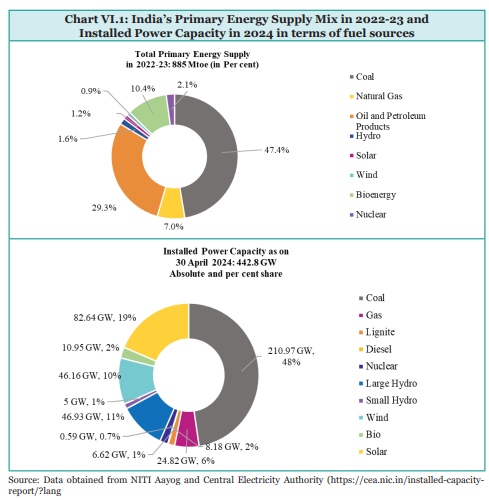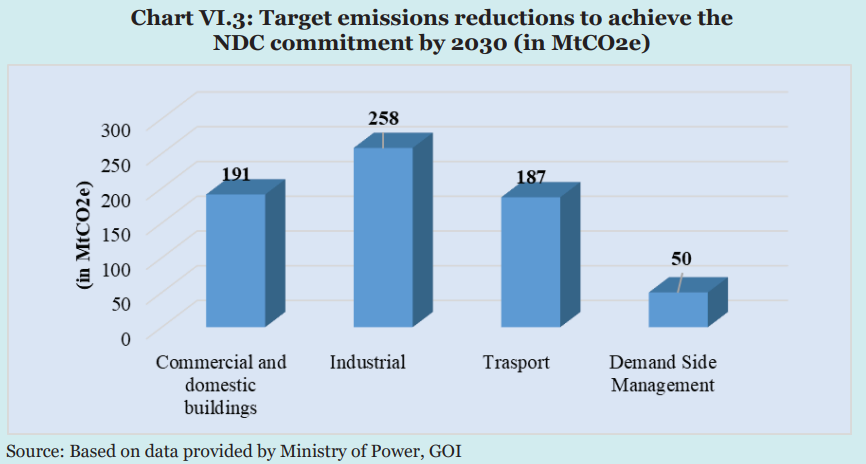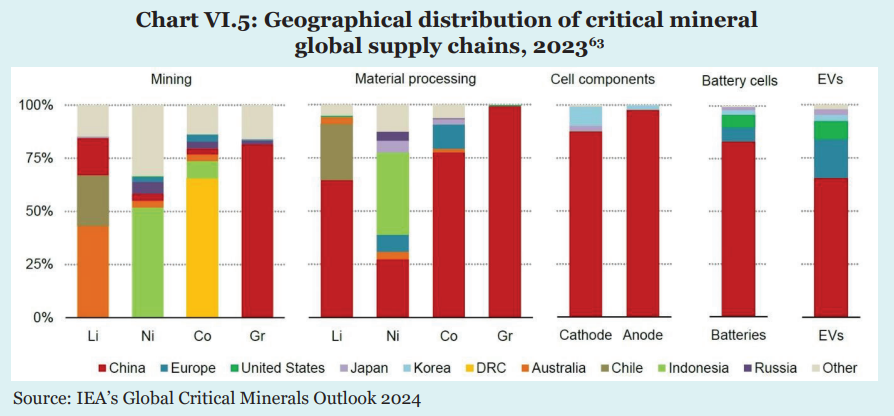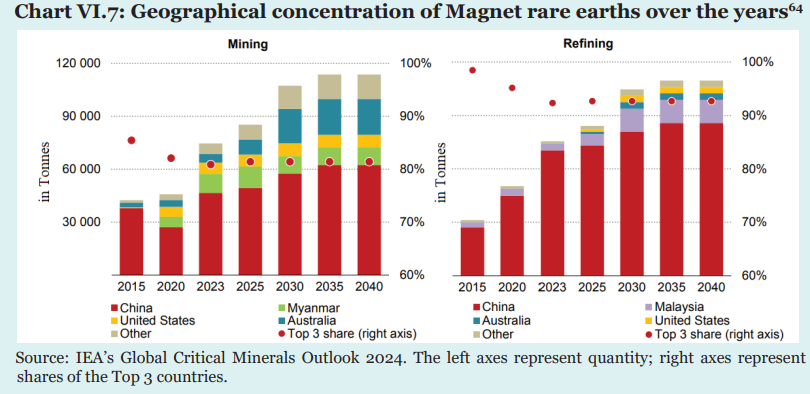Chapter 6: CLIMATE CHANGE AND ENERGY TRANSITION: DEALING WITH TRADE-OFFS
India, one of the fastest-growing economies, has only one-third of the global average carbon emission. India aims to achieve “Viksit Bharat” by 2047 and Net Zero carbon emissions by 2070.
To achieve these goals, India focuses on High economic growth and Inclusive, environmentally sustainable development.
The chapter reviews India’s initiatives and performance in addressing climate change, discusses energy transition issues, and deliberates upon the status of the multilateral negotiations.
PRESENT STATUS OF INDIA’S CLIMATE ACTION
India has adopted the mission-mode approach to address climate change. The National Action Plan on Climate Change (NAPCC) outlines the strategy to enhance the sustainability of the country’s development path. A broad spectrum of climate action – adaptation and mitigation, including demand side management is being taken through the programme.
India’s Achievements:
- India has made significant progress on climate action. The installed solar power capacity reached to 82.64 GW on 30 April 2024.
- A total of 45.4% of Installed electricity generation capacity comes from non-fossil sources.
- The emission intensity of GDP was reduced by 33% from 2005 levels.
- From 2005 to 2019, a carbon sink of 1.97 billion tonnes of CO2 equivalent has been created, and soon to make an additional carbon sink of 2.5 to 3.0 billion tonnes through tree and forest cover by 2030.
- India’s GDP between 2005 and 2019 has grown with a Compound Annual Growth Rate (CAGR) of about 7 per cent, whereas the emissions grew at a CAGR of about 4 per cent. i.e., the rate of emissions growth is lower than the rate of growth of our GDP.
- India is the only G20 country in line with 2-degree centigrade warming.
To meet the NDC targets by 2030, an estimated USD 2.5 trillion is needed with access to finance and technology at a reasonable cost, including from the developed countries; these are essential for easing the constraints on the required resources.
ADAPTATION IS CRITICAL FOR INDIA
According to UNDP, climate change adaptation refers to actions that help reduce vulnerability to climate change’s current or expected impacts, like weather extremes and hazards, slow onset events such as sea-level rise, biodiversity loss, or food and water insecurity.
Lack of resources makes lower-income countries susceptible to increased vulnerability and potential economic disruption. Economic growth enhances the ability of a country to take adaptation action and builds resilience. Therefore, from a developing country’s perspective, continued economic growth is the best insurance against climate change.
India is one of the most climate-vulnerable countries; there is a greater need for adaptive strategies in agriculture and conservation efforts to mitigate the detrimental effects of climate change on natural habitats, vegetation, and vital bio-resources. Several initiatives by the government are as follows:
- NAPCC, with seven of the nine missions addressing it
- Promotion of micro irrigation under the Pradhan Mantri Krishi Sinchayee Yojana (PMKSY),
- The introduction of the National Innovations on Climate Resilient Agriculture (NICRA)
- Steps taken to improve resilience in the economy through programs such as the Swachh Bharat Mission, Mahatma Gandhi National Rural Employment Guarantee Act, Pradhan Mantri Awas Yojana, Saubhagya Scheme, etc.
- For the coastal regions in India, which are more vulnerable to climate change, mangroves and wetland conservation can be important adaptation measures.
- The Government of India announced the ‘Amrit Dharohar’ initiative to promote nature tourism in the conserved Ramsar sites.
- The Mission Sahbhagita is another milestone step towards participatory conservation and wise use of wetlands.
LOW CARBON DEVELOPMENT AND ENERGY COMPOSITION
Low-carbon development is defined as a development strategy that aims at reducing emissions while ensuring economic development and improved welfare. It places economic development as a priority while taking mitigation actions that enable a reduction in emissions.
India’s energy needs are expected to grow 2-2.5 times by 2047 to support economic development and aspirations. To achieve Net Zero by 2070, India must:
- Transition to a diversified energy mix with a significant share of non-fossil sources
- Enhance energy production and usage efficiency
- Phase in renewable energy sources to reduce dependence on fossil fuels
However, this transition must be orderly and consider limited resources and alternative demands on resources for climate resilience and social-economic development.
India’s primary energy supply mix in 2022-23 and India’s installed power capacity in 2024 in terms of fuel sources:

- In 2022-23, India’s primary energy mix was fossil-fuel dominant, with almost 84 per cent met from coal, oil, and natural gas combined.
- As of May 2024, the share of non-fossil power capacity is 45.4 per cent from around 32 per cent in April 2014.
- Recent initiatives for enhancing the production of renewables are as follows.
- First, PM-Surya Ghar Yojana, launched in February 2024, is expected to add 30 GW of solar capacity and reduce 720 million tonnes of CO2 equivalent.
- Second, given India’s 7,600 km long coastline, the Government has notified the national offshore wind energy policy and offshore wind energy lease rules, 2023. Several offshore zones have been identified for harnessing this potential, and viability gap funding for an initial capacity of one gigawatt has been announced recently.
- Third, India’s Green Hydrogen Mission targets five MMT of green hydrogen by 2030. The scheme offers financial incentives to boost electrolyser manufacturing and production.
- At present, three features characterise India’s energy use.
- high use of biomass as a share of the total primary energy supply,
- the predominance of imports of fossil fuel (mainly petroleum) and
- Use of domestic coal for electricity generation.
- With the advancement of solar rooftop installations, the proliferation of solar appliances, and the ramping up of LPG-based cooking, the use of biomass is set to alter significantly.
- Coal accounts for nearly 70 per cent of the total electric generation. To transition towards cleaner energy, the government is implementing several initiatives such as:
- Clean coal initiatives, including the Coal Gasification Mission, with the aim to gasify 100 million tonnes of coal by 2030.
- Coal Bed Methane (CBM) extraction
- Coal-to-hydrogen conversion
- Carbon Capture and Storage (CCS)
- Coal beneficiation through washeries
- Phasing in cleaner coal technologies and phasing in renewables.
All the above-mentioned efforts aim to reduce emissions, enhance environmental sustainability, and decrease reliance on imported fuels.
Steps taken to improve Energy Efficiency
Policymakers recognise the importance of energy efficiency measures in accelerating clean energy transitions while supporting energy security. The measures taken by the country to increase energy efficiency are as follows:
India has an ambitious target of reducing emissions intensity (EI) by 45 percent by 2030. To achieve this, various initiatives have been launched, including:

- Energy Conservation Building Code (ECBC) for commercial buildings
- Star rating program for appliances and buildings
- Shunya labelling program for Net Zero Energy Buildings (NZEB) and Net Positive Energy Buildings (NPEB)
- Standards and Labelling (S&L) program for appliances
- Lifestyle for Environment (LiFE) initiative to promote sustainable lifestyles
- Mission LiFE to encourage individual behavioural change
- Perform, Achieve, and Trade (PAT) schemes for industries
- Carbon Credit Trading Scheme (CCTS)
- Fuel consumption standards for vehicles
- Demand-side management (DSM) interventions
These initiatives have led to significant energy savings, including 51 million tonnes of oil equivalent annual energy savings, ₹1,94,320 Crore annual cost savings and 306 million tonnes of annual CO2 emissions reduction.
Challenges of Energy Transition
India’s renewable energy goals face challenges due to intermittency and discontinuous supply, impacting grid stability in the absence of battery storage. As energy demand rises with development, addressing these issues is crucial.
- It is suggested that the Levelised Cost of Electricity (LCOE) (a measure of the average net present cost of electricity generation for a generator over its lifetime) of renewables like solar has fallen below that of fossil fuels but doesn’t reflect the total costs the economy face, I ignore the cost associated with intermittency and dispatchability.
- Investing in the project may be viable if the LCOE is lower than the electricity tariff.
- One way to resolve the above issues is Round-The-Clock (RTC) renewable energy supply contracts, which can internalize these risks related to intermittency and dispatchability. The objective of the Round-the-Clock (RTC) supply is to match the buyer’s energy demand curve through renewable energy power projects with energy storage systems.
- Many Net Zero technologies required for global Net Zero are currently unavailable (such as hydrogen-fuelled steel/cement, steel, etc.) or in development and require enhanced international R&D cooperation.
- Innovation cycles need to be accelerated to meet emissions targets, and grid balancing and storage are essential for stability.
- Expanding renewables and clean fuels will increase demand for land and water, requiring careful resource management. Most renewables are land-intensive and demand the highest land use requirements among the different energy sources. The scaling required for renewable technologies faces several major challenges, including:
- Water requirements: renewables demand significant water resources.
- Large-scale deployment challenges: technology limitations, infrastructure needs, and resource constraints.
- Land requirements: for example, 1 MW of solar PV requires 1-1.5 hectares of land. The availability of land is a major challenge for India, which has the lowest land availability per capita amongst the G20 countries.

- Renewable waste recycling is another challenge. Globally, solar photovoltaic (PV) waste is estimated to be as massive as 78 million tonnes by 2050.
- To address concerns regarding disposal practices, India recently amended E-Waste (Management) Rules, 2022
- Critical minerals are required for renewable energy and battery storage technologies. The source of such minerals is geographically concentrated, notably Graphite (China, 79 per cent), Cobalt (DRC, 70 per cent), rare earth (China, 60 per cent), and Lithium (Australia, 55 per cent). The concentration level is even higher for processing, with China dominating across the board.
- To enable access to critical critical minerals to smooth the green transition, India has joined the Mineral Security Partnership (MSP), and the Government has also released a list of 30 critical minerals for India.
- Geographical Concentration of Critical and Rare Earth Minerals:

- The above-mentioned Figure 5 shows the profound surge in the geographical concentration of critical and rare earth minerals.
- In the case of refined materials, the share of the top three producing nations has increased since 2020, as shown in Figure 6.

- Further, rare earth elements (REE) that play an important role in clean energy transition are among the least geographically diversified of all key energy transition minerals.
- Magnets made from these are used to achieve higher energy efficiency for automotive traction motors in EVs and wind turbine motors. According to IEA projections, these will likely remain heavily geographically concentrated in the future (Figure 7).

Apart from risks associated with access to technology and raw materials, availability and access to affordable finance are arguably the most crucial challenges to India’s development of a low-carbon path. As per the NITI’s IESS 2047 model, to prepare its energy systems for Net-Zero pathways, India’s total investment cost until 2047 is conservatively estimated at ~ USD 250 billion per year.
Finance for Sustainable Development
India has implemented various measures to enhance its business environment and mobilize resources for sustainable development, encompassing:
- ‘Framework for Sovereign Green Bonds’ in 2022 enabled diversified investors to fund green projects, deepening the bond market and showcasing India’s credibility and readiness to issue sovereign green bonds.
- Issue of sovereign green bonds worth ₹16,000 Crore in January- February 2023 and ₹20,000 Crore in October-December 2023 for public sector projects contributing to reduced emissions intensity.
- SEBI’s (Securities and Exchange Board of India) initiatives:
- Mandatory ESG-related disclosures for the top 100 listed entities since 2012, promoting transparency and accountability.
- It introduced the Business Responsibility and Sustainability Report (BRSR) with quantifiable metrics, enhancing reporting standards.
- RBI’s (Reserve Bank of India) initiatives:
- To foster and develop a green finance ecosystem, RBI has Implemented the Framework for Acceptance of Green Deposits.
- Promotes renewable energy through its Priority Sector Lending (PSL) rules, facilitating concessional credit for renewable energy generation and mitigation projects.
- Non-conventional energy-based public utilities, such as street lighting systems and remote village electrification, should be included in the priority sector classification.
PUTTING IN PLACE A MARKET FRAMEWORK TO PRICE CARBON: INDIAN CARBON MARKET (ICM)
The Indian government has introduced the Carbon Credit Trading Scheme (CCTS) to promote low-emission technologies and incentivize investment in sustainable practices and reducing greenhouse gas emissions.
Some of the important aspects of CCTS are as follows:
- Pricing mechanism: CCTS establishes a market-driven price for carbon emissions, providing a financial incentive for entities to reduce their emissions.
- Obligated entities: Designated consumers under the existing PAT scheme will gradually transition to CCTS by 2028-30, ensuring a smooth phase-out of the old system.
- Emission intensity targets: Entity-wise GHG emission intensity targets will be set, replacing specific energy consumption targets, to enable a per-output emissions limit.
- Compliance mechanism: Registered entities will be notified of GHG emission intensity targets for each annual year, with targets revised for subsequent periods after the trajectory period.
- Carbon Credit Certificates (CCC): Entities achieving greater than the target notified can get CCCs issued, which can be sold in the carbon market or banked for future use.
- Banking and trading: The Banked CCCs can be sold or used to achieve compliance in the following years, while entities failing to meet targets must buy CCCs in the Indian carbon market or use their banked CCCs.
Voluntary Carbon Market (VCM)
Additionally, India also has a thriving Voluntary Carbon Market (VCM), worth over USD 1.2 billion globally, with India being the second-largest supplier of carbon offsets. VCM allows entities to compensate for their emissions through offsetting, enabling them to claim the underlying reduction towards their own emission reduction goals. However, concerns about double counting and uncertainty about credit usage need to be addressed to ensure the integrity of VCM.
Evolution of Carbon Markets
In the 1970s, the concept of carbon markets originated with the United States sulphur dioxide allowance trading program and was later followed by the Montreal Protocol in 1987.
The first international carbon market was established by The Kyoto Protocol in 1997, allowing countries to trade emissions permits to meet their greenhouse gas reduction targets. The protocol had three mechanisms:
- Clean Development Mechanism (CDM)
- Joint Implementation
- International Emissions Trading (IET)
These mechanisms laid the foundation for the international carbon market but faced challenges like limited participation and complex rules.
The European Union Emission Trading Scheme (EU-ETS) was launched in 2005, and Voluntary Carbon Markets gained traction around the same time. However, the second phase of the Kyoto Protocol’s carbon markets failed due to the non-participation of major developed economies and the non-interchangeability of Kyoto credits with EU-ETS.
The Paris Agreement (2015) introduced a new global carbon market framework, allowing countries to voluntarily cooperate through:
- Article 6.2: Voluntary Cooperative Approaches Using Internationally Transferred Mitigation Outcomes (ITMOs)
- Article 6.4: An international mechanism to issue emission credits against mitigation outcomes
Negotiations are ongoing for the implementation of these articles. The Paris Agreement’s carbon market aims to promote sustainable development, ensure environmental integrity, and avoid double counting.
INDIA’S INTERNATIONAL INITIATIVES TO ADDRESS CLIMATE CHANGE ISSUES
India has led several international initiatives towards climate change mitigation and building resilience. Some of these are discussed as follows:
International Solar Alliance (ISA):
- It wasestablished by a joint initiative of India and France in 2015 to deploy solar energy solutions.
- It aims to deploy solar energy solutions and unlock USD 1 trillion in investments by 2030.
- The ISA Supports solar energy demonstration projects and capacity building in member countries.
- ISA has successfully established the Solar Technology and Application Resources Centres (STAR-C) in Ethiopia and Somalia.
One World, One Sun, One Grid (OSOWOG):
- It isan ambitious project led by India and the UK to interconnect solar energy systems on a massive scale.
- It is an ambitious project to interconnect solar energy systems globally.
- It aims to harness solar energy from different parts of the world and transmit it to areas where it is needed.
- Plans to connect the Indian grid with the Middle East, South Asia, and South-East Asia grids in the first phase
Coalition for Disaster Resilient Infrastructure (CDRI)
- It was launched by India during the United Nations Climate Action Summit on 23 September 2019.
- A global partnership to promote infrastructure resilience to climate and disaster risks.
- It aims to enhance infrastructure resilience through capacity building, policy, and planning.
Infrastructure for Resilient Island States (IRIS)
- It’s an initiative led by India to achieve and deliver resilience and climate adaptation solutions to Small Island Developing States (SIDS).
- IRIS has received commitments of USD 35 million from Australia, India, the EU, and the UK, with a target to attract and deploy USD 50 million to support SIDS by 2030
Leadership Group for Industry Transition (LeadIT):
- LeadIT is a partnership between governments and industry to achieve Net Zero goals.
- It aims to shape policy frameworks and international cooperation for an inclusive industry transition.
- LeadIT has launched the second phase (LeadIT 2.0) for 2024-26, focusing on inclusive and just industry transition, co-development and transfer of low-carbon technology, and financial support for industry transition in emerging economies.
Conclusion:
India faces a dual challenge of meeting energy demands while reducing carbon emissions to achieve its growth targets and Net Zero commitment. To address these challenges, India needs to diversify its energy sources such as Renewables (solar, wind, hydro), Nuclear energy, Biofuels, Green hydrogen, and Thermal power (with clean coal technologies).
Diversification will minimize risks associated with energy systems and support low-emission pathways. However, there are challenges and risks associated with each energy source, such as Intermittency of renewables, nuclear waste management, Biofuel production’s impact on food security and high import dependency for solar PV panels and critical minerals.
To address these challenges, India needs to promote clean coal technologies, Enhance international cooperation in R&D for new technologies, Ensure availability, affordability, and accessibility of financial resources for the green transition and focus on nearer-term policy goals of improving human welfare rather than solely focusing on long-term global climate management.





